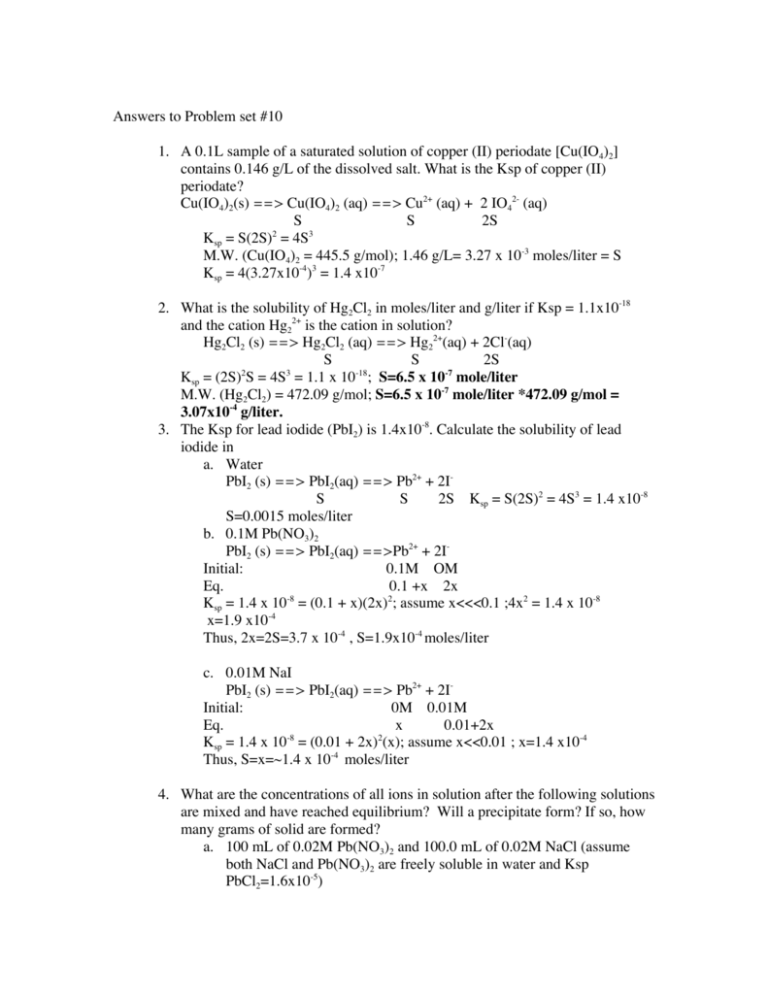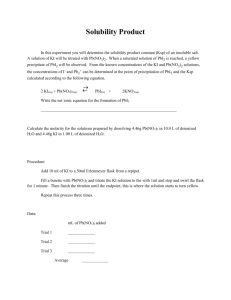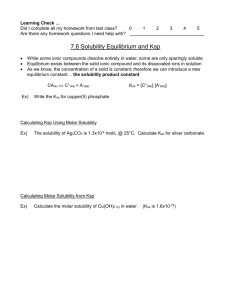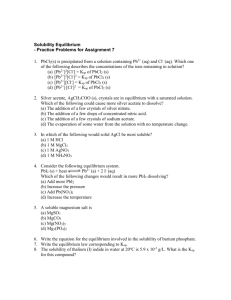Answers to Problem set #10 1. A 0.1L sample of a saturated solution
advertisement

Answers to Problem set #10 1. A 0.1L sample of a saturated solution of copper (II) periodate [Cu(IO4)2] contains 0.146 g/L of the dissolved salt. What is the Ksp of copper (II) periodate? Cu(IO4)2(s) ==> Cu(IO4)2 (aq) ==> Cu2+ (aq) + 2 IO42- (aq) S S 2S 2 3 Ksp = S(2S) = 4S M.W. (Cu(IO4)2 = 445.5 g/mol); 1.46 g/L= 3.27 x 10-3 moles/liter = S Ksp = 4(3.27x10-4)3 = 1.4 x10-7 2. What is the solubility of Hg2Cl2 in moles/liter and g/liter if Ksp = 1.1x10-18 and the cation Hg22+ is the cation in solution? Hg2Cl2 (s) ==> Hg2Cl2 (aq) ==> Hg22+(aq) + 2Cl-(aq) S S 2S 2 3 -18 -7 Ksp = (2S) S = 4S = 1.1 x 10 ; S=6.5 x 10 mole/liter M.W. (Hg2Cl2) = 472.09 g/mol; S=6.5 x 10-7 mole/liter *472.09 g/mol = 3.07x10-4 g/liter. 3. The Ksp for lead iodide (PbI2) is 1.4x10-8. Calculate the solubility of lead iodide in a. Water PbI2 (s) ==> PbI2(aq) ==> Pb2+ + 2IS S 2S Ksp = S(2S)2 = 4S3 = 1.4 x10-8 S=0.0015 moles/liter b. 0.1M Pb(NO3)2 PbI2 (s) ==> PbI2(aq) ==>Pb2+ + 2IInitial: 0.1M OM Eq. 0.1 +x 2x -8 2 Ksp = 1.4 x 10 = (0.1 + x)(2x) ; assume x<<<0.1 ;4x2 = 1.4 x 10-8 x=1.9 x10-4 Thus, 2x=2S=3.7 x 10-4 , S=1.9x10-4 moles/liter c. 0.01M NaI PbI2 (s) ==> PbI2(aq) ==> Pb2+ + 2IInitial: 0M 0.01M Eq. x 0.01+2x Ksp = 1.4 x 10-8 = (0.01 + 2x)2(x); assume x<<0.01 ; x=1.4 x10-4 Thus, S=x=~1.4 x 10-4 moles/liter 4. What are the concentrations of all ions in solution after the following solutions are mixed and have reached equilibrium? Will a precipitate form? If so, how many grams of solid are formed? a. 100 mL of 0.02M Pb(NO3)2 and 100.0 mL of 0.02M NaCl (assume both NaCl and Pb(NO3)2 are freely soluble in water and Ksp PbCl2=1.6x10-5) (0.1L)(0.02M Pb(NO3)2) =0.002 mol Pb2+/0.2L = 0.01M Pb2+ (0.1L)(0.02M NaCl) =0.002 mol Cl-/ 0.2L = 0.01M ClPbCl2 ==> Pb2+ (aq) + 2 Cl-(aq) Initial: 0.01M 0.01M 2+ 2 Ksp = [Pb ]eq[ Cl ]eq Q= (0.01)(0.01)2 = 1x10-6 <Ksp No precipitate will form. Thus [Pb2+]eq = 0.01M and [ Cl-]eq = 0.01M b. 75mL of 0.02M BaCl2 and 125ml of 0.04M Na2SO4 (assume BaCl2 and Na2SO4 are freely soluble in water and that Ksp (BaSO4)=1.1 x 10-10) (.075L) (0.02M BaCl2) = .0015 mol Ba2+ / .2L = .0075 M (0.125L)(0.04 M Na2SO4)= 0.005 mol SO42- / 0.2L = .025 M BaSO4 (s) ==> Ba2+ (aq) + SO42-(aq) Initial: 0.0075M 0.025M -10 2+ Ksp=1.1x10 =[Ba ]eq[SO42-]eq; Q=(0.0075)(0.025)=1.8x10-4>>Ksp Thus, a precipitate will form. Assuming maximum precipitate formation, all Ba2+ will be consumed BaSO4 (s) ==> Ba2+ (aq) + SO42-(aq) New initial: 0M + 0.0175M Equilibrium: x 0.0175 +x Ksp=1.1x10-10 =(x)(0.0175+x); assume x<< 0.0175; x=6.28 x 10-9 Thus, [Ba2+]eq = 6.28x10-9M; [SO42-]eq = 0.0175M BaSO4 precipitated = 0.0075M * 0.2L =0.0015 moles 5. For each of the following ionic compounds, state whether the solubility will increase, decrease, or remain unchanged as a solution at pH 7 is made acidic. a. PbI2 PbI2 ==> Pb2+ (aq) + 2I-(aq) Since I- is the conjugate base of a strong acid (HI), solubility will remain unchanged as the solution is made acidic. b. AgOH AgOH(s) ==> Ag+ (aq) + HO-(aq) Since HO- is the conjugate base of a weak acid (H2O) and is thus a strong base, solubility will increase as the solution is made acidic, since OH is consumed by the added acid. c. Ca3(PO4)2 Ca3(PO4)2 ==> 3Ca2+ (aq) + 2PO43- (aq) Since PO43- is the conjugate base of a weak acid (HPO42-), the solubility will increase as the solution is made acidic 6. The cations in an aqueous solution that contains 0.1M Hg2(NO3)2 and 0.05M Pb (NO3)2 are to be separated by taking advantage of the difference in the solubilities of their iodides Ksp (PbI2) = 1.4 x 10-8; Ksp (Hg2I2) = 1.2 x 10-28. What should be the concentration of iodide ion for the best separation (one in which one of the cations should remain entirely in solution and the other should precipitate as fully as possible)? Assume Hg22+ is the cation in solution from Hg2(NO3)2. Clearly,PbI2 is more soluble than Hg2I2. We need to figure out what concentration of iodide will just precipitate the PbI2 PbI2(s) ==> Pb2+ (aq)+ 2I-(aq) Ksp = [Pb2+]eq[I-]eq2 = (0.05M)[I-]eq2 = 1.4 x10-8; [I-] = 5.3 x10-4M Note that at this concentration: Hg2I2 ==> Hg22+ (aq) + 2I-(aq) Q(Hg2I2)= (0.1M)(5.3x10-4M)2 =2.8 x 10-8>>Ksp(Hg2I2) In contrast, the minimum required concentration of iodide required to precipitate Hg22+ is Ksp = [Hg22+]eq[I-]eq2 = (0.1M)(x)2 = 1.2 x10-28; [I-]=3.4x10-14M Thus , Hg22+ will be selectively precipitated out of solution until the iodide concentration rises to 5.3 x10-4M 7. When 50 mL of 0.1M AgNO3 and 30 mL of 0.06M Na2CrO4 are mixed, a precipitate of of silver chromate (Ag2CrO4) is formed. The Ksp of silver chromate in water is 1.9 x 10-12. Calculate the [Ag+] and [CrO42-] remaining in solution at equilibrium. 50 mL of 0.1M AgNO3 = .005 mol Ag+ / .08L = 0.0625M 30 mL of 0.06M Na2CrO4 = .0018mol CrO42- / .08L = 0.0225 M Ag2CrO4(s) ==> 2Ag+ (aq) + CrO42-(aq) Ksp = 1.9 x 10-12 = [Ag+]eq2[CrO42-]eq Q=(0.0625M)2 (0.0225M) = 8.8 x 10-5>>Ksp Ag2CrO4(s) ==> 2Ag+ (aq) + CrO42-(aq) Initial: 0.0625M 0.0225M New initial: 0.0175M 0M Eq. 0.0175M+2x x Ksp = 1.9 x 10-12 = (0.0175M+2x)2(x) ; assume 2x<<<0.0175M x=6.2x10-9 Thus, [CrO42-]= 6.2x10-9M [Ag+]=0.0175M+2x = 0.0175M 8. The enamel of your teeth contains hydroxyapatite (Ca5(PO4)3OH, Ksp= 6.8x10-37) write out the chemical equation & solubility product expression for the dissolution of this substance in water. It is known that tooth decay starts when bacteria in the mouth convert sugar into organic acids. Why might this be so? Flouridation of drinking water (0.7 to 1.2 ppm) and in dental products converts hydroxyapatite to Ca5(PO4)3F (Ksp=1 x10-60). How does this prevent tooth decay? Ca5(PO4)3OH(s) ==> 5 Ca2+ (aq) +4 PO43-(aq) + HO-(aq) Ksp =[Ca2+]5[PO43-]4[HO-] = 6.8x10-37 Organic acids, though weak, can react completely with the strong base HO-, thus increasing the solubility of hydroxyapatite, which results in enamel/tooth decay Ca5(PO4)3F(s) ==> 5 Ca2+ (aq) +4 PO43-(aq) + F-(aq) Ksp =[Ca2+]5[PO43-]4[F-] = 1 x10-60 Fluoride is clearly a much weaker base than HO-, with a poor tendency to react with weak acids; also comparing Ksp values, Ca5(PO4)3F has much poorer solubility in water than Ca5(PO4)3OH. Both of these features combined prevent tooth decay








